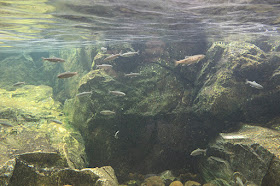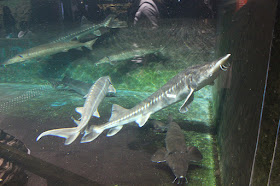For
most people, “zoos” and “aquariums” are places where you go to see living
animals. “Museums”, on the other hand, are usually places where you go to see
preserved specimens of dead animals. At
Lake Biwa Museum in Shiga Prefecture, visitors can see a little of both. The museum features exhibits explaining the natural
history, the cultural history, and the biology of Lake Biwa. At the same time, about one-third of the
museum is comprised of an aquarium showcasing the aquatic creatures of Lake
Biwa as well as creatures from other parts of the world.
Visitors
to the museum will usually first pass through the section of more typical “museum-type”
natural history displays featuring geological, fossil, and biological
specimens, and cultural history displays showing artifacts of human life around
the lake.
The Aquarium Section
This section occupies an
entire floor of one of the wings of the museum, and is located on the floor
below the earlier mentioned museum-type display room. The entrance to the aquarium area features
interesting wire sculptures of fish.
A
number of the exhibits featuring “local” fish of Lake Biwa were constructed
such that the glass window of the tank also served as a glass window of the
building itself, with the fish occupying a pond physically located on the
outside of the building. Since my visit
was in the middle of summer, I thought that it might be very interesting to
visit again during the winter when the pond outside might be surrounded by snow.
Many
of the exhibits were simple rectangular fish tanks.
Some
of the tanks were more interesting in design.
This tubular passageway allowed you to experience a walk on the bottom
of Lake Biwa.
There
was a special tank dedicated to the Lake Biwa Catfish. These creatures are said to grow much larger
than ordinary catfish. The catfish in
this tank were quite shy, and they hid in the shadows of the tank. Fortunately, a metal replica of the catfish allowed
visitors to see what the animal looked like.
The
display below simulated a modern stream environment populated by Ayu Sweetfish.
Exhibit
for Japanese Stream Toad
Birds of Lake Biwa
The
display pictured below housed a Black-headed gull Yurikamome (Larus ridibundus)
and a pair of Little Grebes Kaitsuburi
(Tachybaptus ruficollis) which is the
prefectural bird of Shiga.
The Foreigners
In addition to housing
creatures native to Lake Biwa, this aquarium also featured creatures from other
regions. One of these was a lone Baikal
Seal, the only living mammal featured in this collection. The display of this animal might be called
into question: it is not native to Lake Biwa and doesn’t seem to be a natural “fit”
in this collection, and the display area seemed a bit too small. Although this animal was more than 1.5 meters
in length, the exhibit area was only about 6 or 7 meters wide and only about 3
or 4 meters from the front glass to the back wall. About one-third of this small interior
consisted of a concrete shelf, with the other two-thirds being a featureless
swimming pool about 1.5 meters deep. One
gets the impression that this seal may have been introduced into the collection
mainly in order to attract crowds with its cuteness.
Another
exhibit featuring specimens from other lands was a large tank housing large “ancient”
fishes: sturgeons and gars that are said to have retained the same form since
they evolved millions of years ago.
Opportunities for
Animal Encounters
There was a touch tank
featuring small animals such as crayfish and other small stream creatures. Contact was supervised by museum staff.
Educational Efforts
The
fact that this aquarium was part of a museum was evident in the great amount of
educational signage and displays located throughout the aquarium area.
Many
of these exhibits centered on the relation between the animals and the humans
living near Lake Biwa, and one particularly interesting exhibit was a full-size
replica of a fish seller’s storefront.
The
plastic models of the fish were amazingly realistic.
There
were also plastic replicas of popular dishes made with fish from Lake Biwa.
This
particular exhibit explained a dish called funazushi,
which is basically fermented carp.
By
lifting the cover of this white cylinder, visitors can experience the pungent
smell of funazushi. I am told it is most similar to blue cheese.
Almost Alive
Although this blog is about
zoos and aquariums and living animals, I would like to spend some space
introducing the part of the museum (the part with the dead animals) that was
dedicated to the nature of Lake Biwa.
This area featured a number of taxidermy specimens of amazingly high
quality. For starters, these Cormorants in
the tree looked very much alive.
Even
the Cormorants’ guano, which is a problem in some locations around Lake Biwa,
was faithfully recreated.
You
could pick up this replica to get a sense of how little a Cormorant weighs.
This
forest scene featured a taxidermy specimen of a deer.
The
fallen leaves and tree roots appeared to be the real thing.
My
favorite area was the section featuring replica plants and preserved animals.
This
wall display of the birds of Lake Biwa included 113 individual specimens.
The
specimens appeared as if they could fly away at any second.
There
were also specimens of the mammals of the area.
These also seemed as if they were still alive.
These
mice specimens looked so alive that it was almost creepy.
Food and Souvenirs
There
was a museum coffee shop which featured dishes made of large-mouth bass. The bass, originally introduced to Japan from
the United States, has been designated as a problematic invasive species, and
there are campaigns to create consumer demand for the fish caught as part of eradication
efforts.
Getting There
Since
a friend drove me to the museum, I can’t report on how much the public
transportation costs. According to the
museum brochure, visitors taking the train should get off at the JR Kusatsu
Station. From there, visitors can ride
the Omi Dentetsu bus heading to “Karasuma Hantou” which will take about 25
minutes. Alternatively, a taxi from JR Kusatsu Station, or from JR Moriyama Station, will take about 20 minutes. Admission to the museum is 750 yen for
adults, 400 yen for high school and college students.
(Note:
All photos taken in this post were taken during a visit on July 16, 2016. The comments in this post are based on
observations made on that day. Conditions
may have since changed. Please check it
out for yourself!)











































































